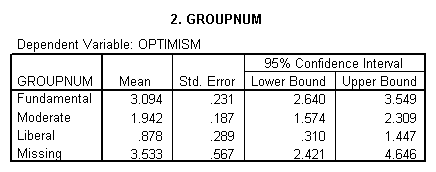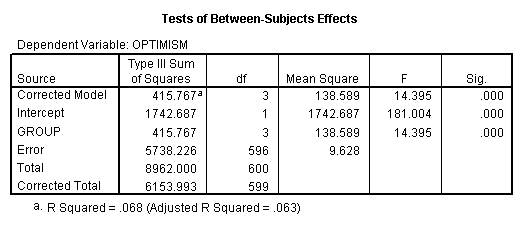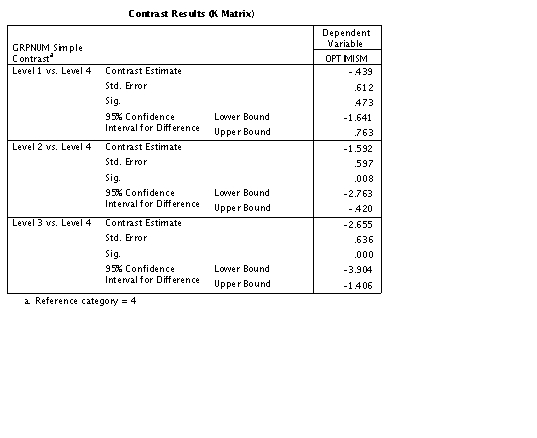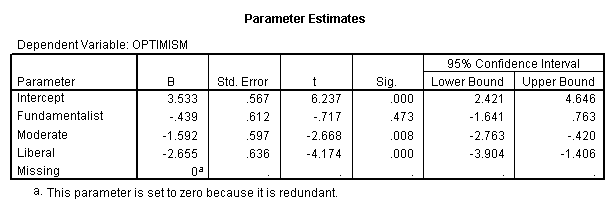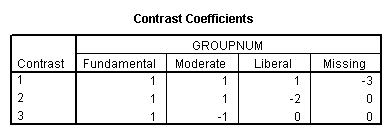I am going to use a set of data from a study that I was involved with some time ago and published as Epping-Jordan, Compas, & Howell (1994). It dealt with cancer outcomes (improved versus not improved) as a function of several variables.These include Survrate (a rating by the oncologist of the individuals expected survival time, Prognosis (a four point scale), Amttreat (amount of treatment, GSI (the Glocal Symptom Index from Derogatis' Symptom Checklist 90), Avoid (a measure of avoidance behavior), and Intrus (a measure of intrusive thoughts. The original data are available at survrate.dat. For this example I doubled the sample size by randomly adding or subtracting random numbers from the data in the original set. This left me with the original 66 cases and an additional 66 pseudocases. I did this simply to create a better example. The full set of 132 cases had no missing observations. so we can begin with a logistic regression on a full data set and use these results for comparison. Having a full data set, I randomly deleted 35 observations and replaced them with a missing data code. This file is available at survrateMissing999.dat. The 999 in that title indicates that for this particular set I used 999 as a missing data code. (For SAS I will change 999 to ".", and for R I will change 999 to "NA." For some software I will include variable labels in line 1, and for other software I will leave the labels out.)
The results of a standard logistic regression on the data set with no missing values follows. For this analysis I used SAS, but I could have done the same thing with any other program.
There are a number of alternative ways of dealing with missing data, and this document is an attempt to outline those approaches. The original version of this document spent considerable space on using dummy variables to code for missing observations. That idea was popularized in the behavioral sciences by Cohen and Cohen (1983). However, that approach does not produce unbiased parameter estimates (Jones, 1996), and is no longer to be recommended--especially in light of the availability of excellent software to handle other approaches. For a very thorough book-length treatment of the issue of missing data, I recommend Little and Rubin (1987) .A shorter treatment can be found in Allison (2002) . Perhaps the nicest treatment of modern approaches can be found in Baraldi & Enders (2010). I have recently written a chapter on missing data for an edited volume (Howell, 2007). Part of that paper forms the basis for some of what is found here. You can write me at David.Howell@uvm.edu for a copy of that missing data chapter.
I am in the process of revisng this page by breaking it into at least two pages. It has grown much too long and probably no one is eager to read all the way through it. When I am done, this page will cover missing data in general and focus primarily on the situation where we either look for ways to use the data in its original form, or use traditional missing data techniques such as listwise deletion and mean replacement. I will cover situations that involve both multiple linear regression and the analysis of variance. The next document (Missing Data Part Two) focuses on newer data imputation methods which replace the missing data with a best guess at what that value would have been if you were able to obtain it. This is the material that most people now think of under the heading of "missing data,", but the former material is still important and often very useful.
If your interest is in missing data in a repeated measures ANOVA , you will find useful material at http://www.uvm.edu/~dhowell/StatPages/More_Stuff/Missing_Data/Mixed Models for Repeated Measures.pdf .
1.1 The nature of missing data
Missing completely at random
There are several reasons why data may be missing. They may be missing because equipment malfunctioned, the weather was terrible, people got sick, or the data were not entered correctly. Here the data are missing completely at random (MCAR). When we say that data are missing completely at random, we mean that the probability that an observation (Xi) is missing is unrelated to the value of Xi or to the value of any other variables. Thus data on family income would not be considered MCAR if people with low incomes were less likely to report their family income than people with higher incomes. Similarly, if Whites were more likely to omit reporting income than African Americans, we again would not have data that were MCAR because missingness would be correlated with ethnicity. However if a participant's data were missing because he was stopped for a traffic violation and missed the data collection session, his data would presumably be missing completely at random. Another way to think of MCAR is to note that in that case any piece of data is just as likely to be missing as any other piece of data.
Notice that it is the value of the observation, and not its "missingness," that is important. If people who refused to report personal income were also likely to refuse to report family income, the data could still be considered MCAR, so long as neither of these had any relation to the income value itself. This is an important consideration, because when a data set consists of responses to several survey instruments, someone who did not complete the Beck Depression Inventory would be missing all BDI subscores, but that would not affect whether the data can be classed as MCAR.
This nice feature of data that are MCAR is that the analysis remains unbiased. We may lose power for our design, but the estimated parameters are not biased by the absence of data.
Missing at random
Often data are not missing completely at random, but they may be classifiable as missing at random (MAR). (MAR is not really a good name for this condition because most people would take it to be synonymous with MCAR, which it is not. However, the label has stuck.) Let's back up one step. For data to be missing completely at random, the probability that Xi is missing is unrelated to the value of Xi or other variables in the analysis. But the data can be considered as missing at random if the data meet the requirement that missingness does not depend on the value of Xi after controlling for another variable. For example, people who are depressed might be less inclined to report their income, and thus reported income will be related to depression. Depressed people might also have a lower income in general, and thus when we have a high rate of missing data among depressed individuals, the existing mean income might be lower than it would be without missing data. However, if, within depressed patients the probability of reported income was unrelated to income level, then the data would be considered MAR, though not MCAR. Another way of saying this is to say that to the extent that missingness is correlated with other variables that are included in the analysis, the data are MAR.
The phraseology is a bit awkward here because we tend to think of randomness as not producing bias, and thus might well think that Missing at Random is not a problem. Unfortunately it is a problem, although in this case we have ways of dealing with the issue so as to produce meaningful and relatively unbiased estimates. But just because a variable is MAR does not mean that you can just forget about the problem. But nor does it mean that You have to throw up your handes and declare that there is nothing to be done
The situation in which the data are at least MAR is sometimes referred to as ignorable missingness. This name comes about because for those data we can still produce unbiased parameter estimates without needing to provide a model to explain missingness. Cases of MNAR, to be considered next, could be labeled cases of nonignorable missingness.
Missing Not at Random
If data are not MCAR or MAR then they are classed as Missing Not at Random (MNAR). For example, if we are studying mental health and people who have been diagnosed as depressed are less likely than others to report their mental status, the data are not missing at random. Clearly the mean mental status score for the available data will not be an unbiased estimate of the mean that we would have obtained with complete data. The same thing happens when people with low income are less likely to report their income on a data collection form.
When we have data that are MNAR we have a problem. The only
way to obtain an unbiased estimate of parameters is to model
missingness. In other words we would need to write a model that
accounts for the missing data. That model could then be
incorporated into a more complex model for estimating missing
values. This is not a task anyone would take on lightly. See
Dunning and Freedman (2008) for an
example. However even if the data are MNAR, all is not lost. Our estimators may be biased, but the bias may be small.
1.2 Traditional treatments for missing data
The simplest approach--listwise deletion.
By far the most common approach to missing data is to simply omit those cases with missing data and to run our analyses on what remains. Thus if 5 subjects in group one don't show up to be tested, that group is 5 observations short. Or if 5 individuals have missing scores on one or more variables, we simply omit those individuals from the analysis. This approach is usually called listwise deletion, but it is also known as complete case analysis.
Although listwise deletion often results in a substantial decrease in the sample size available for the analysis, it does have important advantages. In particular, under the assumption that data are missing completely at random, it leads to unbiased parameter estimates. Unfortunately, even when the data are MCAR there is a loss in power using this approach, especially if we have to rule out a large number of subjects. And when the data are not MCAR, bias results. (For example when low income individuals are less likely to report their income level, the resulting mean is biased in favor of higher incomes.) The alternative approaches discussed below should be considered as a replacement for listwise deletion, though in some cases we may be better off to "bite the bullet" and fall back on listwise deletion.
1.3 Other Not-So-Good Approaches
A poor approach--pairwise deletion
Many computer packages offer the option of using what is generally known as pairwise deletion but has also been called "unwise" deletion. Under this approach each element of the intercorrelation matrix is estimated using all available data. If one participant reports his income and life satisfaction index, but not his age, he is included in the correlation of income and life satisfaction, but not in the correlations involving age. The problem with this approach is that the parameters of the model will be based on different sets of data, with different sample sizes and different standard errors. It is even quite possible to generate an intercorrelation matrix that is not positive definite, which is likely to bring your whole analysis to a stop.
It has been suggested that if there are only a few missing observations it doesn't hurt anything to use pairwise deletion. But I would argue that if there are only a few missing observations that it doesn't hurt much to toss those participants out and use complete cases. If there are many missing observations you can do considerable harm with either analysis. In both situations the approaches given below are generally preferable.
I want to talk about a few approaches that are sometimes used and that we know are not very wise choices. It is important to talk about these because it is important to discourage their use, but more importantly because they lead logically to modern approaches that are very much better.
Hot deck imputation
Hot deck imputation goes back over 50 years and was used quite successfully by the Census Bureau and others in better times. I have included it here partly for historical reasons and partly because it represents an approach of replacing data that are missing.
In the 1940's and '50's most citizens seemed to feel that they had a responsibility to fill out surveys, and, as a result, relatively little data was missing. Suppose that in the 1950 census a young, black, male resident of census block 32a either was not available or refused to participate. The census bureau would simply take a stack of Hollerith cards (you may know them as "IBM cards"--or you may not even know them at all) that came from young, black males in census block 32a, reach in the pile, and pull one out at random. That card was substituted for the missing card and the analysis continued. That is not as outrageous a procedure as it might seem at first glance. First of all there were relatively few missing observations to be replaced. Second the replacement data was a random draw from a collection of data on similar participants. Third the statistical implications of this process were thought to be pretty well understood. I don't believe that hot deck imputation is much used anymore, but it served its purpose at the time. Scheuren (2005) has an interesting discussion of how the process was developed within the U. S. Census Bureau.
Mean substitution
An old procedure that should certainly be relegated to the past was the idea of substituting a mean for the missing data. For example, if you don't know my systolic blood pressure, just substitute the mean systolic blood pressure for mine and continue. There are a couple of problems with this approach. In the first place it adds no new information. The overall mean, with or without replacing my missing data, will be the same. In addition, such a process leads to an underestimate of error. Cohen et al. (2003) gave an interesting example of a data set on university faculty. The data consisted of data on salary and citation level of publications. There were 62 cases with complete data and 7 cases for which the citation index was missing. Cohen gives the following table.
| Analysis | N | r | b | St. Err. b |
| Complete cases | 62 | .55 | 310.747 | 60.95 |
| Mean substitution | 69 | .54 | 310.747 | 59.13 |
Notice that using mean substitution makes only a trivial change in the correlation coefficient and no change in the regression coefficient. But the st. err (b) is noticeably smaller using mean substitution. That should not be surprising. We have really added no new information to the data but we have increased the sample size. The effect of increasing the sample size is to increase the denominator for computing the standard error, thus reducing the standard error. Adding no new information certainly should not make you more comfortable with the result, but this would seem to. The reduction is spurious and should be avoided--as we'll see below.
Regression substitution
If we don't like mean substitution, why not try using linear regression to predict what the missing score should be on the basis of other variables that are present? We use existing variables to make a prediction, and then substitute that predicted value as if it were an actual obtained value. This approach has been around for a long time and has at least one advantage over mean substitution. At least the imputed value is in some way conditional on other information we have about the person. With mean substitution, if we were missing a person's weight we assigned him the average weight. Put somewhat incorrectly, with regression substitution we would assign him the weight of males of around the same age. That has to be an improvement. But the problem of error variance remains. By substituting a value that is perfectly predictable from other variables, we have not really added more information but we have increased the sample size and reduced the standard error.
There is one way out of this difficulty, however, is known as stochastic regression imputation. The approach adds a randomly sampled residual term from the normal (or other) distribution to each the imputed value. SPSS has implemented this in their Missing Value Analysis procedure. By default that procedure adds a bit of random error to each substitution. That does not totally eliminate the problem, but it does reduce it. There are better ways, however, and they build on this simple idea.
1.4 The Special Case of Missing Group Membership
Missing Identification of Group Membership
I am about to make the distinction between regression and ANOVA models. This may not be the distinction that others might make, but it makes sense for me. I am really trying to distinguish between those cases for which group membership is unknown and cases in which the substantive variables are unknown.
I will begin with a discussion of an approach that probably
won't seem very unusual. In experimental research we usually know
which group a subject belongs to because we specifically assigned
them to that group. Unless we somehow bungle our data, group
membership is not a problem. But in much applied research we
don't always know group assignments. For example, suppose that we
wanted to study differences in optimism among different religious
denominations. We could do as Sethi and Seligman (1993) did and
hand out an optimism scale in churches and synagogues, in which
case we have our subjects pretty well classified with respect to
religious affiliation because we know where we recruited them.
However we could instead simply hand out the optimism scale to
many people on the street and ask them to check off their
religious affiliation. Some people might check "None," which is a
perfectly appropriate response. But others might think that their
religious affiliation is not our business, and refuse to check
anything, leaving us completely in the dark. I would be hard
pressed to defend the idea that this is a random event across all
religious categories, but perhaps it is. Certainly "no response"
is not the same as a response of "none," and we wouldn't want to
treat it as if it were.
The most obvious thing to do in this situation would be to drop
all of those non-responders from the analysis, and to try to
convince ourselves that these are data missing completely at
random. (Even if we did convince ourselves, I doubt we would fool
our readers.) But a better approach is to make use of the fact
that non-response is itself a bit of data, and to put those
subjects into a group of their own. We would then have a specific
test on the null hypothesis that non-responders are no different
from other subjects in terms of their optimism score. And once we
establish the fact that this null hypothesis is reasonable (if we
should) we can then go ahead and compare the rest of the groups
with somewhat more confidence. On the other hand, if we find that
the non-responders differ systematically from the others on
optimism, then we need to take that into account in interpreting
differences among the remaining groups.
An Example
I will take the data from the study by Sethi and Seligman (1993) on optimism and religious fundamentalism as an example, although I will assume that data collection involved asking respondents to check a box specifying their religious affiliation. These are data that I created and analyzed elsewhere to match the results that Sethi and Seligman obtained, although for purposes of this example I will alter those data so as to remove "Religious Affiliation" from 30 cases. I won't tell you whether I did this randomly or systematically, because the answer to that will be part of our analysis. The data for this example are contained in a file named FundMiss.dat, which is available for downloading, although it is much too long to show here. (The variables are, in order, ID, Group (string variable), Optimism, Group Number (a numerical coding of Group), Religious Influence, Religious Involvement, Religious Hope, and Miss (to be explained later).) We will assume that when respondents are missing any data, the data are missing on Group membership and on all three religiosity variables, but not on Optimism. Essentially our respondents are telling us that their religious beliefs are not our business. (Missing values are designated here with a period (.). If your software doesn't like periods as missing data (and SPSS no longer does), you can take any editor and change periods to asterisks (*), or blanks, or 999s, or whatever it does like. R uses the symbol "NA" for missing observations.) This is the kind of result you might find if the religiosity variables all come off the same measurement instrument and that instrument also has a place to record religious affiliation. We see cases like this all the time. The dependent variable for these analyses is the respondent's score on the Optimism scale, and the resulting sample sizes, means, and standard deviations are shown in Table 1, as produced by SPSS.
- - Description of Subpopulations - - Summaries of OPTIMISM By levels of GROUPNUM Group Membership Variable Value Label Mean Std Dev Cases For Entire Population 2.1633 3.2053 600 GROUPNUM 1 Fundamentalist 3.0944 2.8573 180 GROUPNUM 2 Moderate 1.9418 3.1629 275 GROUPNUM 3 Liberal .8783 3.2985 115 GROUPNUM 4 Missing 3.5333 3.1919 30 Total Cases = 600
- Table 1 Descriptive Statistics for Optimism as a Function of Group Membership
From this table we see that there are substantial differences
among the three groups for whom Religious Affiliation is known.
We also see that the mean for the Missing subjects is much closer
to the mean of Fundamentalist than to the other means, which
might suggest that Fundamentalists were more likely to refuse to
provide a religious affiliation than were members of the other
groups.
The results of an analysis of variance on Optimism scores of all four groups is presented in Table 2. Here I have asked SPSS to use what are called "Simple Contrasts" with the last (missing) group as the reference group. This will cause SPSS to print out a comparison of each of the first three groups with the Missing group. I chose to use simple contrasts because I wanted to see how Missing subjects compared to each of the three non-missing groups.
- Table 2 Analysis of Variance with All Four Groups -- Simple Contrasts
At the top of Table 2 you see the means of the four groups, as
well as the unweighted mean of all groups (labeled Grand Mean).
Next in the table is an Analysis of Variance summary table,
showing that there are significant differences between groups;
(F3,599 = 14.395; p = .000).
A moment's calculation will show you that the difference between the mean of Fundamentalists and the mean of the Missing group is 3.094 - 3.533 = -0.439. Similarly the Moderate group mean differs from the mean of the Missing group by 1.942 - 3.533 = -1.591, and the Liberal and Missing means differ by 0.878 - 3.533 = -2.655. Thus participants who do not give their religious affiliation have Optimism scores that are much closer to those of Fundamentalists than those of the other affiliations.
In the section of the table labeled "Parameter Estimates" we
see the coefficients of -.439, 1.592, and -2.655. You should note
that these coefficients are equal to the difference between each
group's mean and the mean of the last (Missing) group. Moreover,
the t values in that section of the table represent a
significance test on the deviations from the mean of the Missing
group, and we can see that Missing deviates significantly from
Moderates and Liberals, but not from Fundamentalists. This
suggests to me that there is a systematic pattern of non-
response which we must keep in mind when we evaluate our data.
Subjects are not missing at random because missingness depends on
the value of that variable. (Notice that the coefficient for
missing is set at 0 and labeled "redundant." It is redundant
because if someone is not in the Fundamentalist, Moderate, or
Liberal group, we know that they are missing. "Missing," in this
case, adds no new information.)
Orthogonal Contrasts
You might be inclined to suggest that the previous analysis doesn't give us exactly what we want because it does not tell us about relationships among the three groups having non-missing membership. In part, that's the point, because we wanted to include all of the data in a way that told us something about those people who failed to respond, as well as those who did supply the necessary information.
I am going to move slightly away from the problem of missing data in order to make this example more complete. If you prefer, you can jump to the next main heading. For those who want to focus on those subjects who provided Religious Affiliation while not totally ignoring those who did not, an alternative analysis would involve the use of orthogonal contrasts not only to compare the non-responders with all responders, but also to make specific comparisons among the three known groups. But keep in mind that because the data are not MCAR the means, particularly the grand mean, is likely to be biased. (If Fundamentalists are less likely to respond, and if they have higher optimism scores, the grand mean of optimism will be biased downward from what it would have been had they responded.)
You can use SPSS (OneWay) or any other program to perform the contrasts in question. (Or you can easily do it by hand). Suppose that I am particularly interested in knowing how the non-responders differ from the average of all responders, but that I am also interested in comparing the Moderates with the other two identified groups, and then the Fundamentalists with the Liberals. I can run these contrasts by providing SPSS with the following coefficients.
Missing vs Non-Missing 1 1 1 -3
(Fundamental & Moderate) vs Liberals 1 1 -2 0
Fundamental vs Liberal 1 -1 0 0
The first contrast deals with those missing responses that have caused us a problem, and the second and third contrasts deal with differences among the identified groups. The results of this analysis are presented below. (I have run this using SPSS syntax because it produces more useful printout.)
ONEWAY optimism BY groupnum(1 4) /CONTRAST= 1 1 1 -3 /CONTRAST= 1 1 -2 /CONTRAST= 1 -1 /HARMONIC NONE /FORMAT NOLABELS /MISSING ANALYSIS .

Table 3 OneWay Analysis of Variance on Optimism with Orthogonal Contrasts
Notice in Table 3 that the contrasts are computed with and
without pooling of error terms. In our particular case the
variances are sufficiently equal to allow us to pool error, but,
in fact, for these data it would not make any important
difference to the outcome which analysis we used. In Table 3 you
will see that all of the contrasts are significant. This means
that non-responders are significantly different from (and more
optimistic than) responders, that Fundamentalists and Moderates
combined are more Optimistic than Liberals, and that
Fundamentalists are in turn more optimistic than Moderates.
I have presented this last analysis to make the point that you have not lost a thing by including the missing cases in your analysis relative to running the analysis excluding missing observations. The second and third contrasts are exactly the same as you would have run if you had only used the three identified groups. However, this analysis includes the variability of Optimism scores from the Missing group in determining the error term, giving you somewhat more degrees of freedom. In a sense, you can have your cake and eat it too, although, as I noted above, the overall mean is biased relative to what it would have been had we collected complete data.
Cohen and Cohen (1983, Chapter 7) provide additional comments on the treatment of missing group membership, and you might look there for additional ideas. In particular, you might look at their treatment of the case where there is missing information on more than one independent variable.
This situation, where data on group membership is missing, is handled by the analysis above. Notice that, other than the overall mean, the analysis is not dependent on the nature of the mechanism behind missingness, which is in fact addressed by the analysis. This will not necessarily be the case in the following analysis, where the nature of missingness is important.
1.5 The More General Case of Missing Dependent Variables
We have a different kind of problem when we have data missing on the dependent variable that makes the results of our study much more difficult to interpret. If our data are in the form of a one-way analysis of variance, and if we can assume that data are missing completely at random, things are not particularly bad. We will lose power because of smaller sample sizes, and the means of larger groups will be estimated with less error than means of smaller groups, but we will not have problems with biased estimates. But keep in mind that I'm speaking here of data that are missing completely at random.
But suppose that our data are not missing completely at random. Suppose that we are comparing two treatments for hypertension. In the ideal study we have all participants take the medication they are prescribed and then we compare blood pressure levels at the end of treatment. But in the real world we know that there is usually a dropout problem in medical studies. In particular, those who are not helped by the treatment are more likely to drop out, or to die. If one drug is quite successful and the other is pretty much a failure, the sample size will be very much smaller in the second treatment. Moreover, those who remain, and whose blood pressure is eventually measured, are likely to be the ones who benefitted from the treatment. So if we see that the means of the two groups are nearly equal at the end of treatment, we might be led to the conclusion that the two treatments are equally effective. In fact, one was a horrible treatment but we didn't have data from its "failures." In such a setting missing data make the interpretation of means quite risky. (Perhaps the most appropriate statistic would be the drop out rate instead of the mean.)
Missing Data Imputation
This is where I am going to split off and create a separate web page on the problem of missing dependent variables. The techniques there are quite a bit more sophisticated that those we have seen so far, but with software that is now generally available, there is much that we can do to salvage our study. To continue, go to Missing data imputation
Alternative Software Solutions
I have shown how to do this with NORM. I was asked by a former student if I could write something that was a step-by-step approach to using NORM, and that document is available at "MissingDataNorm.html".
You can also do something similar with SPSS and with SAS. In addition, there is an R program called Amelia (in honor of Amelia Earhart). I have written (or will write) instructions for the use of those programs. An important point, however, is that each program uses its own algorithm for imputing data, and it is not always clear exactly what algorithm they are using. For all practical purposes it probably doesn't matter, but I would like to know.
- For a page on SPSS, go to MissingDataSPSS.html.
- For SAS, see MissingDataSAS.html.
The continuation page for this material can be found at Missing Data Part Two.
References
Allison, P. D. (2001) Missing Data
Thousand Oaks, CA: Sage Publications.Return
Barladi, A. N. &s;
Enders, C. K. (2010). An introduction to modern missing data analyses.
Journal of School Psychology, 48, 5-37.Return
Cohen, J. & Cohen, P. (1983) Applied
multiple regression/correlation analysis for the behavioral
sciences (2nd ed.).Hillsdale, NJ: Erlbaum. Return
Cohen, J. & Cohen, P., West, S. G. &
Aiken, L. S. (2003). Applied Multiple
Regression/Correlation Analysis for the Behavioral Sciences,
3rd edition. Mahwah, N.J.: Lawrence Erlbaum.
Return
Dunning, T., & Freedman, D.A. (2008)
Modeling section iffects. in Outhwaite, W. & Turner, S.
(eds) Handbook of Social Science Methodology. London:
Sage. Return
Howell,D. C. (2007)
The analysis of missing data. In Outhwaite, W. & Turner, S. Handbook of Social Science Methodology. London: Sage.Return
Little, R.J.A. & Rubin, D.B. (1987)
Statistical analysis with missing data. New York,
Wiley. Return
Jones, M.P. (1996). Indicator and
stratification methods for missing explanatory variables in
multiple linear regression Journal of the American
Statistical Association, 91,222-230. Return
Schafer, J. L. (1997). Analysis of incomplete multivariate data, London, Chapman & Hall.">
Schafer, J.L. & Olsden, M. K.. (1998). Multiple imputation for multivariate missing-data problems: A data analyst's perspective. Multivariate Behavioral Research, 33, 545-571.Return
Scheuren, F. (2005). Multiple imputation:
How it began and continues. The American Statistician,
59, : 315-319.Return
Sethi, S. & Seligman, M.E.P. (1993).
Optimism and fundamentalism. Psychological Science, 4,
256-259. Return
Last revised 6/28/2015


